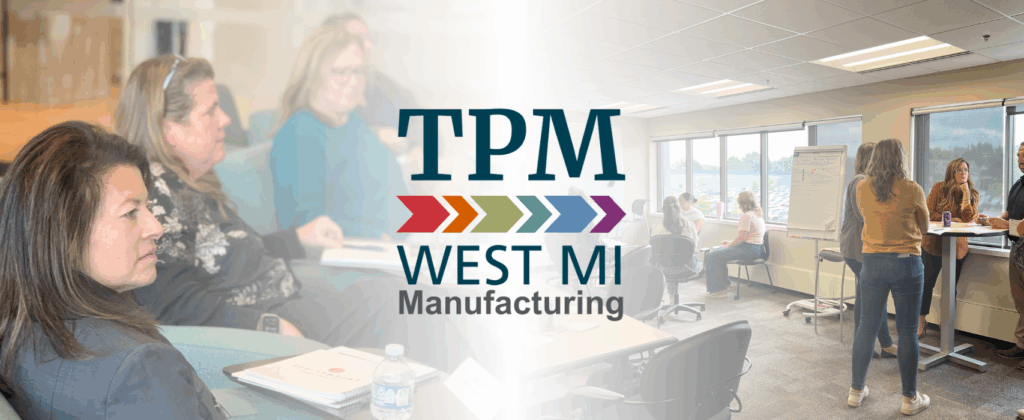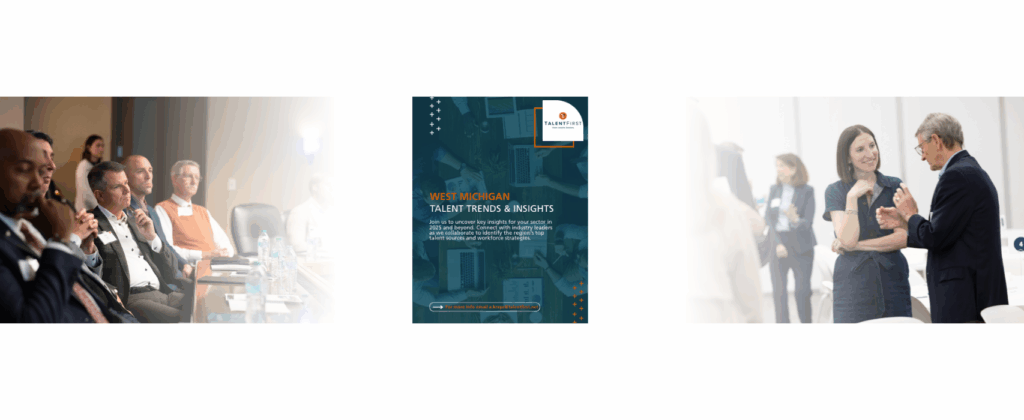AI is no longer a distant concept — it’s here, reshaping industries and redefining how people work. From advanced manufacturing and healthcare to financial services and logistics, AI is disrupting traditional roles while unlocking new possibilities across West Michigan.
At TalentFirst’s recent session on AI and the Future of Work, leaders from across industries in West Michigan gathered to explore how AI is transforming jobs, skills, and career pathways. The session combined real-time labor market data, an engaging Q&A, and a dynamic panel of local leaders building and deploying AI solutions.
The Double-Edged Sword of AI
The data presentation set the stage by clarifying what AI is — and isn’t. Far from a wholesale replacement for people, AI today is primarily an augmentor: it reduces redundancy and automates repetitive tasks so humans can focus on creativity, leadership, and problem-solving. Some quick examples—
- In customer service, AI takes on routine inquiries, freeing people to build relationships.
- In healthcare, AI tools handle charting and documentation, allowing clinicians to spend more time with patients.
But the data also highlighted challenges unique to West Michigan. AI adoption here trails both the state and the nation. At the same time, occupations in management, architecture, and computer/mathematical fields are especially exposed to automation. Entry-level jobs are at risk of erosion, creating long-term implications for talent pipelines.
Key Insights from the Panel Discussions and Q&A
The Q&A session revealed deeper tensions:
- Entry-level squeeze: Employers face a difficult choice — automate entry-level roles to cut costs, or invest in young talent to preserve future pipelines.
- Big vs. small companies: Larger firms are moving faster on AI adoption, while smaller businesses hesitate due to costs.
- AI literacy: Beyond just using tools like ChatGPT, AI literacy requires understanding how systems work on the back end, building trust, and promoting responsible use.
Panel: Building the Future of Work with AI
The panel brought together diverse perspectives from law, finance, technology, and workforce leadership:
- Mark Johnson, Michigan Software Labs shared how AI allowed a manufacturer to reallocate employees from routine accounts payable tasks to higher-value client negotiations. “Humans use knowledge and experience to solve problems, and AI takes the other parts,” he explained.
- Sarah Miklusicak, Lake Michigan Credit Union described how AI is reshaping workforce planning: “We’re adopting AI and robotics to supplement and enable our people — not replace them. Our people are our bread and butter.” She emphasized the importance of balancing efficiency with human connection, noting that members still want a branch nearby, even if they rarely use it.
- Mark Wassink, Warner Norcross + Judd focused on risks and governance. “If your team isn’t using AI, you need to figure out how to use it. But you must protect sensitive information, client confidentiality, and accuracy. That requires policies and planning.”
- Carly Smyly, TalentFirst emphasized agility and timelines: “We need to act now on what’s possible in 12 months, plan for the next 1–3 years, and prepare for long-term shifts. If we fix things upstream now, it will shape the workforce positively for years to come.”
Human-Centered Transformation
Throughout the conversation, one theme emerged: durable skills remain the human advantage. Critical thinking, empathy, adaptability, and leadership are becoming even more valuable as AI handles routine tasks.
Panelists also acknowledged generational gaps. Younger workers are entering the labor market with less experience in critical thinking and interpersonal skills, while retirees are leaving with decades of institutional knowledge. As Sarah Miklusicak put it, “The bulk will fall on employers. Onboarding, mentorship, and partnerships with universities are essential to bridge the gap.”
And while AI is transforming the landscape, human relationships remain irreplaceable. “As much as people want awesome tech, they also ask for face-to-face interaction,” said Miklusicak. “It’s not a sprint. Change has to be sustainable.”
A Call to Action
AI is both a challenge and an opportunity for West Michigan. To stay competitive and inclusive, employers and educators must:
- Invest in AI literacy and skills-first hiring.
- Preserve and adapt entry-level opportunities to ensure long-term pipelines.
- Center durable human skills — creativity, trust, empathy, and critical thinking.
- Adopt responsible governance to manage risks without stalling innovation.
- Build resilience through workforce planning that looks 1, 3, and 5 years ahead.
As Mark Johnson concluded: “Now is the time to solve problems with AI, not go around them.”
Shaping the Future Together
The future of work in West Michigan won’t be defined by whether AI arrives — it’s already here. It will be defined by how we choose to use it: to augment human potential, create equitable opportunities, and build a resilient, future-ready workforce.
At TalentFirst, we believe that with the right strategies, West Michigan can lead the way.


